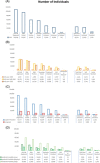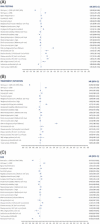Engagement with the HCV care cascade among high-risk groups: A population-based study
- PMID: 37556245
- PMCID: PMC10412431
- DOI: 10.1097/HC9.0000000000000222
Engagement with the HCV care cascade among high-risk groups: A population-based study
Abstract
Background: HCV elimination requires a thorough understanding of the care cascade. A direct-acting antiviral (DAA)-era description of the care cascade has not been undertaken in Ontario, Canada's most populous jurisdiction. Our primary objective was to describe the current population-level care cascade in the general Ontario population and among key risk groups ─ baby boomers, immigrants, and individuals experiencing residential instability. The secondary objective was to identify predictors of engagement.
Methods: We conducted a population-based cohort study of Ontario residents undergoing HCV testing between January 1, 1999, and December 31, 2018, and mapped the care cascade [antibody-diagnosed, RNA tested, RNA positive, genotyped, treated, achieved sustained virologic response, reinfected/relapsed] as of December 31, 2018. The cascade was stratified by risk groups. Cause-specific hazard modeling was used to identify demographic, and socioeconomic predictors of engagement with key steps of the cascade.
Results: Among 108,428 Ontario residents living with an HCV antibody diagnosis, 88% received confirmatory RNA testing; of these, 62% tested positive and 94% of positive tests were genotyped. Of those with confirmed viremia, 53% initiated treatment and 76% of treated individuals achieved sustained virologic response, while ~1% experienced reinfection or relapse. Males, older birth cohorts, long-term residents, those with a history of substance use disorder and social marginalization (eg, material deprivation, residential instability), and those initially diagnosed in the pre-DAA era exhibited lower rates of engagement with almost every step of HCV care.
Conclusions: Despite DAA era improvements, treatment initiation remains a major gap. HCV screening and linkage-to-treatment, particularly for those with a history of substance use disorder and social marginalization, will be needed to equitably close gaps in HCV care in the province.
Copyright © 2023 The Author(s). Published by Wolters Kluwer Health, Inc. on behalf of the American Association for the Study of Liver Diseases.
Conflict of interest statement
Aysegul Erman is employed at Janssen Pharmaceuticals. William W.L. Wong received grants from the Canadian Liver Foundation outside the submitted work. The remaining authors have no conflicts to report.
Figures


References
-
- World Health Organization (WHO). “Resolution WHA67.6” (2014).
-
- Yasseen AS, Kwong JC, Feld JJ, Janjua NZ, Greenaway C, Lapointe-Shaw L, et al. . Viral hepatitis C cascade of care: A population-level comparison of immigrant and long-term residents. Liver Inter [Internet]. 2021;41:1775–1788. - PubMed
-
- Wong WWL, Erman A, Feld JJ, Krahn M. Model-based projection of health and economic effects of screening for hepatitis C in Canada. CMAJ-Open [Internet]. 2017;5:E662–E672. http://cmajopen.ca/lookup/doi/10.9778/cmajo.20170048[cited 2021 Dec 29] /pmc/articles/PMC5621948/ - DOI - PMC - PubMed
-
- Hamadeh A, Haines A, Feng Z, Thein HH, Janjua NZ, Krahn M, et al. . Estimating chronic hepatitis C prevalence in British Columbia and Ontario, Canada, using population-based cohort studies. J Viral Hepat [Internet]. 2020;27:1419–1429. - PubMed
Publication types
MeSH terms
Substances
Grants and funding
LinkOut - more resources
Full Text Sources
Medical
Miscellaneous

